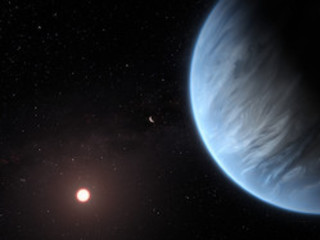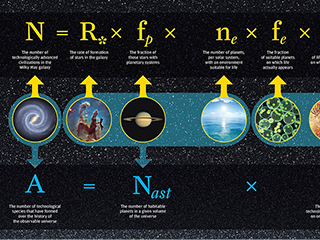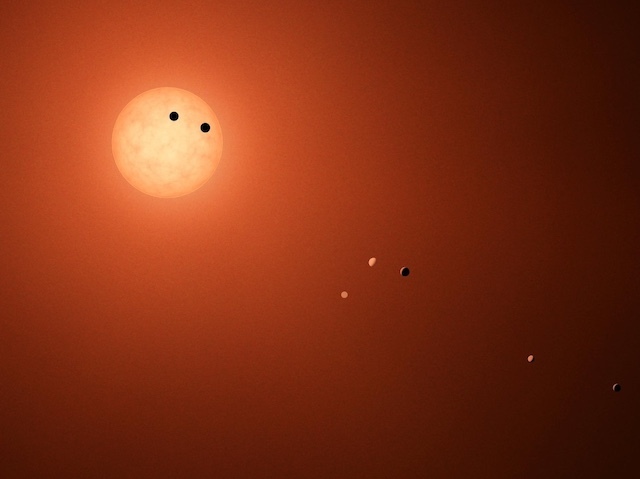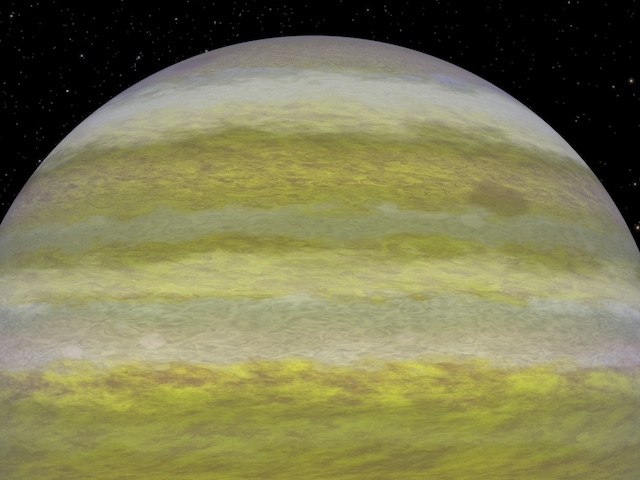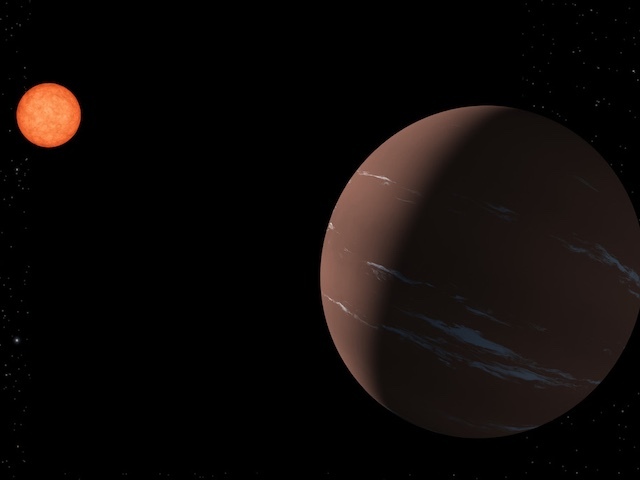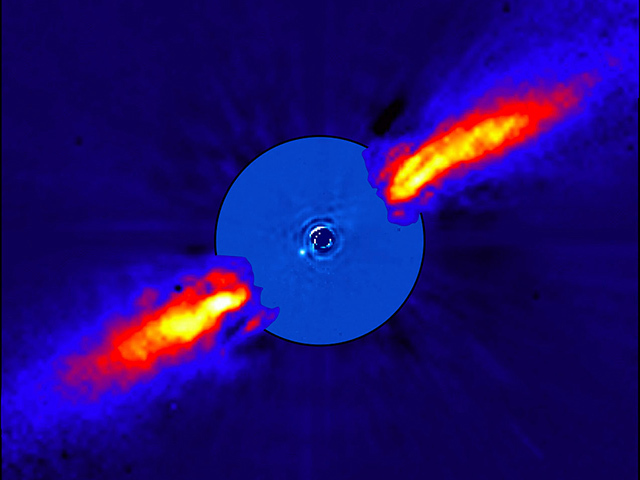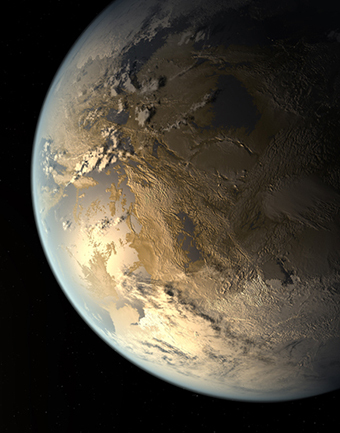News | January 6, 2020
New Technique May Give NASA's Webb Telescope a Way to Quickly Identify Planets with Oxygen

Conceptual image of water-bearing (left) and dry (right) exoplanets with oxygen-rich atmospheres. Crescents are other planets in the system, and the red sphere is the M-dwarf star around which the exoplanets orbit. The dry exoplanet is closer to the star, so the star appears larger.
Credits: NASA/GSFC/Friedlander-Griswold
Researchers may have found a way that NASA's James Webb Space Telescope can quickly identify nearby planets that could be promising for our search for life, as well as worlds that are uninhabitable because their oceans have vaporized.
Since planets around other stars (exoplanets) are so far away, scientists cannot look for signs of life by visiting these distant worlds. Instead, they must use a cutting-edge telescope like Webb (set to launch in 2021) to see what's inside the atmospheres of exoplanets. One possible indication of life, or biosignature, is the presence of oxygen in an exoplanet’s atmosphere. Oxygen is generated by life on Earth when organisms such as plants, algae and cyanobacteria use photosynthesis to convert sunlight into chemical energy.
But what should Webb look for to determine if a planet has a lot of oxygen? In a new study, researchers identified a strong signal that oxygen molecules produce when they collide. Scientists say Webb has the potential to detect this signal in the atmospheres of exoplanets.
“Before our work, oxygen at similar levels as on Earth was thought to be undetectable with Webb, but we identify a promising way to detect it in nearby planetary systems,” said Thomas Fauchez of the Universities Space Research Association at NASA’s Goddard Space Flight Center in Greenbelt, Maryland. “This oxygen signal is known since the early '80’s from Earth’s atmospheric studies, but has never been studied for exoplanet research.” Fauchez is the lead author of the study, appearing in the journal Nature Astronomy Jan. 6, 2019.
The researchers used a computer model to simulate this oxygen signature by modeling the atmospheric conditions of an exoplanet around an M dwarf, the most common type of star in the universe. M dwarf stars are much smaller, cooler and fainter than our Sun, yet much more active, with explosive activity that generates intense ultraviolet light. The team modelled the impact of this enhanced radiation on atmospheric chemistry, and used this to simulate how the component colors of the star's light would change when the planet would pass in front of it.
As starlight passes through the exoplanet’s atmosphere, the oxygen absorbs certain colors (wavelengths) of light— in this case, infrared light with a wavelength of 6.4 micrometers. When oxygen molecules collide with each other or with other molecules in the exoplanet’s atmosphere, energy from the collision puts the oxygen molecule in a special state that temporarily allows it to absorb the infrared light. Infrared light is invisible to the human eye, but detectable using instruments attached to telescopes.
“Similar oxygen signals exist at 1.06 and 1.27 micrometers and have been discussed in previous studies but these are less strong and much more mitigated by the presence of clouds than the 6.4 micrometer signal,” said Geronimo Villanueva, a co-author of the paper at Goddard.
Intriguingly, oxygen can also make an exoplanet appear to host life when it does not, because it can accumulate in a planet’s atmosphere without any life activity at all. For example, if the exoplanet is too close to its host star or receives too much star light, the atmosphere becomes very warm and saturated with water vapor from evaporating oceans. This water could be then broken down by the strong ultraviolet radiation into atomic hydrogen and oxygen. Hydrogen, which is a light atom, escapes to space very easily, leaving the oxygen behind.
Over time, this process can cause entire oceans to be lost while building up a thick oxygen atmosphere. So, abundant oxygen in an exoplanet’s atmosphere does not necessarily mean abundant life, but may instead indicate a rich water history.
“Depending upon how easily Webb detects this 6.4 micrometer signal, we can get an idea about how likely it is that the planet is habitable,” said Ravi Kopparapu, a co-author of the paper at Goddard. “If Webb points to a planet and detects this 6.4 micrometer signal with relative ease, this would mean that the planet has a very dense oxygen atmosphere and may be uninhabitable.”
The oxygen signal is so strong that it also can tell astronomers whether M dwarf planets have atmospheres at all, using just a few Webb transit observations.
“This is important because M dwarf stars are highly active, and it has been postulated that stellar activity might ‘blow away’ entire planetary atmospheres,” said Fauchez. “Knowing simply whether a planet orbiting an M dwarf can have an atmosphere at all is important for understanding star-planet interactions around these abundant but active stars.”
Although the oxygen signal is strong, cosmic distances are vast and M dwarfs are dim, so these stars will have to be relatively nearby for Webb to detect the signal in exoplanet atmospheres within a reasonable amount of time. An exoplanet with a modern Earth-like atmosphere will have to be orbiting an M dwarf that is within approximately 16 light-years of Earth. For a desiccated exoplanet with an oxygen atmosphere 22 times the pressure of Earth’s, the signal could be detected up to about 82 light-years away. One light-year, the distance light travels in a year, is almost six trillion miles. For comparison, the closest stars to our Sun are found in the Alpha Centauri system a little over 4 light-years away, and our galaxy is about 100,000 light-years across.
The research was funded in part by Goddard’s Sellers Exoplanet Environments Collaboration (SEEC), which is funded in part by the NASA Planetary Science Division's Internal Scientist Funding Model. This project has also received funding from the European Union’s Horizon 2020 research and innovation program under the Marie Sklodowska-Curie Grant, the NASA Astrobiology Institute Alternative Earths team, and the NExSS Virtual Planetary Laboratory.
Webb will be the world's premier space science observatory, when it launches in 2021. It will solve mysteries in our solar system, look beyond to distant worlds around other stars, and probe the mysterious structures and origins of our universe and our place in it. Webb is an international project led by NASA with its partners, ESA (European Space Agency) and the Canadian Space Agency.
Bill Steigerwald / Nancy Jones
NASA Goddard Space Flight Center, Greenbelt, Maryland
301-286-8955 / 301-286-0039

